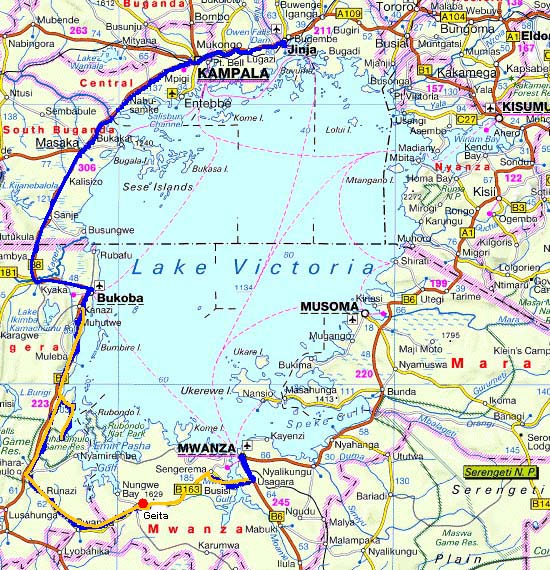
| Greetings Home |
| Previous Greeting |
| Next Greeting |
| Previous Dhow Logbook |
| Next Dhow Logbook |
Crtd 05-05-02 Lastedit 15-10-27
No Wood
(kwa hakika)
It is now end of April, 2005. Since Tanzania Shillings 3 Million (US$ 3000) were paid
as first advance to the Best Dhow Yard In Town more than two months ago and witnesses could not
unambiguously confirm any trace of what could be part of my dhow on the said
premises, I decided to head for Mwanza. Some 20 minutes
after departure I had to return because I realized I forgot the dongle (USB
key-chip) of my Fugawi GPS navigation software, absolutely essential for a trip
like this. I felt like a prisoner who had to apply to his warden to have his
handcuffs removed for the trip. Who the hell they think they are, these Fugawi
software guys, this is the last time I buy from them. The trip to Mwanza was to
be along the West side of the Lake Victoria, because the Fugawi maps promised
lots of forest on approaching Mwanza from there. If availability of
mninga wood
for my dhow was a problem, I could do some research of my own. The distance to Mwanza along
this West side is the same as over the East, but it took some time before
someone could tell me about the road quality. It was good tarmac I was told.

Map. My journey around the lake (900 km). The yellow part is maram
Still in Uganda, South of Masaka, along
the lake towards the Tanzanian border, life seemed to be confined to rural
dwelling in grass-thatched huts with clay or brick walls. It being dusk, I
decided to look for a secure parking for five minutes more and then
return to the town for night shelter with serious security guards. Four minutes later an arrow "Masaka Back
Packers Camp Site" stood at the road side. A steep clay path uphill led to a fenced one acre grass
compound with a beautiful panorama view to the Tanzania side. Every now and then
you meet a simple living but smart and industrious Ugandan who got his own idea
and realized it. Joseph used his family compound to start a simple but beautiful
Garden of Eden and the wazungu found him:
he is in the East Africa Lonely Planet, I was told by other guests.
Cold beer, local food, what more would I want?
A girl from the village appeared, kneeling to Joseph in the traditional way. She
asked for a book to read. Joseph has a full shelf for his guests. She got one. In a
dance-run,
she disappeared through the gate. I was moved almost to tears seeing her go. She
must be an isolated person in a world where most children leave primary school
without being able to read, let alone being interested in books. [more
about Joseph]
The border. It starts with people in nice suits assuming authority and asking
you detailed questions about what you have and where you go. These are crooks
posing as officials, calling themselves "Customs Clearing Agents". The first time
you say you do not need them, on insisting you tell them not to try
interfering with your business, and on insisting still, as I once did to my
enjoyment, you knock them straight to the ground. Then there are the money
changers, whose difference between buying and selling exchange rate of Tanzania
and Uganda Shillings is 50% and more. Some have better rates
but that is because they sell counterfeit. All these crooks and fake officials have
bribed themselves in the clearing zones of Uganda and Tanzania, so the "real"
officials get there fair share. This is the procedure for border passage: first all your data are
taken by Uganda police in order to cross check immigration and customs officials for
corruption. Then immigration stamps your passport for leave of Uganda, and you pay US$
20 for "temporary export" of your car to Tanzania to customs. NO! This habit of Uganda
customs at the Kenya side turned out not be known to their colleagues here at the West side
Uganda border with Tanzania! Only extensive paper work.
In the Uganda customs office an official is quite openly unpacking a sack with
three new shirts given to him by an Indian transporter to speed things up and
reduce border crossing cost.
Excuse me Sir?
Can I clear my car?
You need Miss Mai, she is downstairs.
Miss Mai is nowhere. Crooks offer me to call her for a small fee. I return to
the office. One of the self appointed "Customs Clearing Agents" that I pushed
off my chest is just leaving: "You're not yet done Sir?".
No but neither did I spend anything.
Mister New-Shirts is now behind his desk.
No trace of Miss Mai, Sir, can your clear me?
With a sigh of fatigue he agrees.
What is the value of you car?
I bought it last year for USh 14 Million, so may be 11 now.
No, then is should be 13.
OK 13.
Etc.
The Tanzanian side.
On the Tanzanian side, Tanzanians can pay in Tanzanian Shillings. From all
others, Ugandans, Congolese, Europeans they accept US dollars only. There is
an exception: Euros are taken, one euro counts as one dollar, you loose 25%.
The immigration wants US$ 50. For my car the the Tanzanian customs authority wants
me to copy by hand all data written on the Ugandan customs authority form in a
slightly different format. I see the car-value on the my Ugandan form, completed
by Mr. New-Shirt: Uganda Shilling 30 Million instead of 13.
Never mind Sir, the Tanzanian officer says, it is just a formality. But what he
does want is another
US$25. Uganda Shillings not accepted. Tanzania shillings not accepted. Euros
yes, one euro is one dollar.
I hand over US$ 100.
No. Today we do not accept US$
100 bills because we have no change. I am advised to try and find someone who
can change my US$ 100 bill. Otherwise, stay for the night (it is 9 o'clock in
the morning) for the Customs Office might have the change tomorrow.
Just to release some frustration I tell them I live in Uganda, I go to Tanzania,
and what the hell has the US, a country on the other side of the earth, to do
with our business.
It is a government rule Sir.
And does the government also have the rule that the customs offices should have
the change in dollars??
This is a very rare occurrence Sir.
I give him US$ 25 in small dollar bills.
He wants to keep my car's logbook (my official Ugandan government's proof of ownership,
indispensable for any border crossing), to be handed back when
I return.
I refuse.
He accepts.
He gives me a form to be completed while in Tanzania, before returning to the border. A 10 page
questionnaire about customer satisfaction with border officials.
Then they want to check my car.
Finally I have to go to the police office, who take all my data once again in
order to cross check the Tanzanian immigration and customs authorities for corruption.
This cross check works just as
well as at the Uganda side, that is: we know us.
The best rate to buy Tanzania Shillings for Uganda shillings is 20% above the
middle rate.
I decide to change little and go to a bank in the harbour place Bukoba, one hour
down the road (map).
But in Bukoba, banks only change hard currencies to
Tanzania Shillings. The take no Uganda Shillings.
In a remarkable well organised
tourist office, I was assisted
by a Dutchman (!), Bart
Lacroix, who arranged a private trader offering the same rate as at the
border.
|
Bukoba Tourist office Bukoba: see
map |
East African Union countries regard each other's currencies as junk money. When
Ugandans, Tanzanians and Kenyans travel to each other's countries, they take US
dollars and nothing else. The US dollar is the true currency of the East African
Union. A good idea, but then why not abolish the local currencies altogether.
Then, 40 km South of Bukoba the impeccable tarmac went over in maram. Maram is a
very hard type of Afican red clay. The art of building a maram road is to dig
deep, fill with large stone blocs, so called aggregates, then
equalize with small
stones, the size ranging between a golf and a tennis ball. Finally, sand and
maram fills the holes to make a nicely flat and hard surface that drives
comfortably up to 70 km/hrs, Africans hold: 100. Since maram quickly dissolves in
water, rain should sink vertically down in it or drip off the shortest way, that
is: across. Hence the road is much more convex than a tarmac road, has deep
trenches aside from where side channels branch off to carry the water to the
bush.
So far for theory.
In practice the maram road, even more than the African tarmac road is notorious
for potholes, round depressions caused by the locally sinking down of the small
stones, after which tires press out the liquefied maram in wet weather. Then,
you have the longitudinal carvings made by streams of water that are formed on
sloping parts of the road. Then after the entire road starts to sink down, you
have cross carvings from streams simply carrying rain water from the one side of
the road to the other. Finally, at the lowest parts of valleys, you will find
mud pools and entire ponds up to 1 meter deep. Where the soil is rocky, sharp
stones will emerge from the surface in a density of 10 per square meter that
ruin your tires if your speed exceeds 20 km/hrs.
How far until the next tarmac? I asked a policeman at a roadblock.
Only 70 km, Sir.
Ok, that is something one can bear. To have to drive the remaining 400 km to
Mwanza on maram would be a complete reason to return home and go along the East
side of the lake.
After shaking for half an hour on the very lonely maram road, with fewer and
fewer huts on the side, my temperature meter went down to zero. A true character
test. I checked the water level and felt its temperature, and tried to convince
myself that this was a meter defect: it had started to indicate too low. Uphill
it still came up to 25%. After some more hours I really was convinced and
forgot about it. It became dark but I was determined to get off the maram before
finding a safe place to sleep.
My laptop map and GPS were off, because maram is not the environment to have
your hardware bumping around in your cabin. Anyway, there was clearly one main
road to Mwanza.
Then, in a village, a road branched off to the right that looked serious.
Mwanza? I asked the bodobodo boys at the junction, pointing straight.
Yes, Mwanza, they all nodded.
But an hour later I saw the lake in the dusk and knew that was not a likely view
from the planned route.
I switched on GPS and computer navigation maps. My detailed maps showed the
branch was the main road and I had gone for the lake and then further South to
"Biharamulo Game Reserve" (see
map). Now my mood changed: this road went South as well, and I
could safely sleep far from people between the wild animals! But in the park
there was no way to get off the road, not a single side path doable for a car.
And while sleeping, my car should be absolutely invisible from the road. Finally
the road seemed to head back to the main road to Mwanza, the tarmac! I thought
to be saved without a high price after all, the real game reserve was across a
river left of me that came from the main road.
Then the road crossed the river and headed back to the lake.
I turned the car and decided to take one of the small shortcuts to the main
roads my Fugawi GPS navigation maps had on offer. But none of them turned out to
exist. Apparently Fugawi draws lines on hearsay and concentrates mainly on
producing dongles.
So, I drove the whole way back till where the village guys nodded me into the
wrong branch. At midnight, after having passed some ten year
olds who decided to throw a handful of gravel through my open window (and they
throw hard and accurate), I arrived at a closed roadblock with a police post.
Everybody was asleep, but I felt safe to sleep as well.
Before dawn an officer uninvitedly opened a zipper of my car tent, asked the
three familiar questions on which every thug should be well prepared (where do
you come from, where to you go, what is the purpose of your travel), and told me I was free to pass when I was ready to do so. I
lifted the bamboo barrier and a new day was born.
Maram maram maram. Western people think they know what it means to drive 25
km/hrs. They have no idea. It means that after one hour, you did 25 km. After a
day, you did 250. That is what is means. For lorries, maram means driving 15 km
an hour instead of 80 or even 100. That is: you need 6 lorries instead of one to
do the same job. And above that, the lorries are wearing out five times as fast.
The cost of tarmac are no match to those maram transport cost.
My reason for choosing this side of the lake was the forest drawn on the Fugawi
maps east of Mwanza. Mninga for my dhow?
But I saw only shrubs, no forest. And baboons, baboons. Not exactly an
endangered species. Fortunately shy for people at this side, so you do not need
to close your window every five minutes.
Picture: maram with baboons.
Then a few kilometers after Geita (see map), suddenly my temperature meter started to indicate normally! But 20 seconds later, a smell of burning rubber made me stop immediately. A one pound stone had hit my radiator in the middle. The cooling system was emptied and impossible to fill. This could have happened 150 km from the nearest serious garage. In a little Toyota truck like mine, derived from the minibuses, the engine is below the passenger seat. With this seat lifted, keeping the engine wet with water from my jerry can, aiming as much I could on the steaming opening of the cooling system, stopping many times for extra cooling, I drove back to Geita. Fortunately, I know that even a good garage looks like this (see picture):
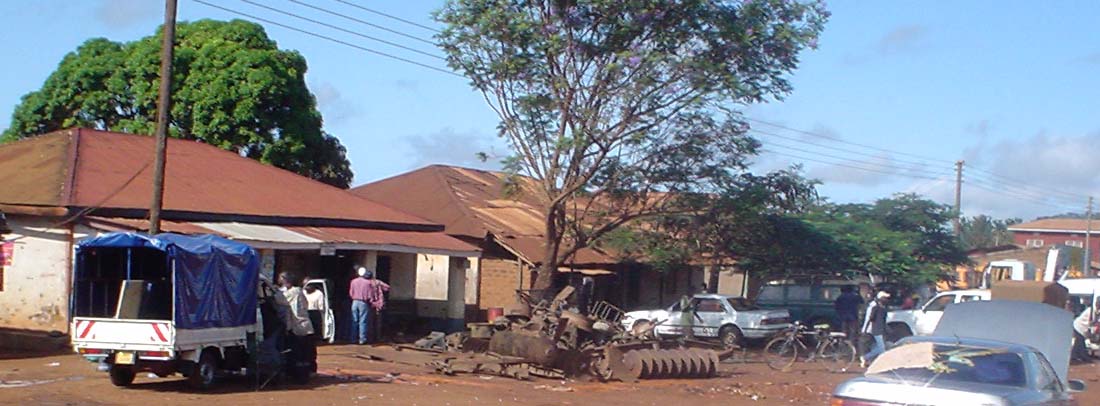
There was, the garage boys told me, no chance to find such a radiator for sale in Geita. After a failed attempt to fill the leaks in the night, the next morning, after another three hours we did a test trip with the radiator repaired as follows:
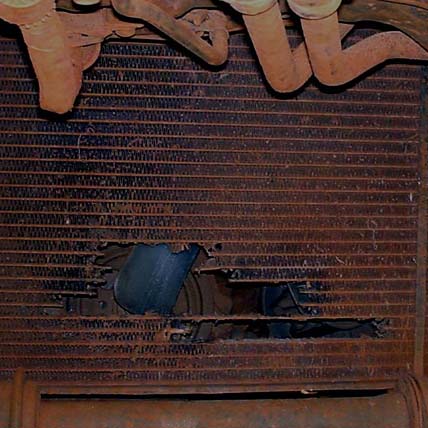
Picture: radiator repaired
I would, the boys
said, reach Mwanza with it. US$ 30. Moved by their craftsmanship, the typical
African one: absolute concentration, ingenious tricks and few tools, and a free
fill of my water jerry can for any event not hoped for, I said goodbye.
No more mninga tree search. After all, if there is no forest, it is not hard to
know that there are no trees, a fortiori
no mninga trees.
Maram, all the way to the ferry, where I found a kilometer line of lorries. I
decided to pass them and drive to the gate of the ferry.
Should I line up behind the lorries? I asked the guard.
Yes.
I saw days of waiting before me.
Yes, but park there. He pointed to a tree at the road side.
I parked and made an estimation of the number of trucks in line. Surely over 50.
How big would the ferry be? Not worth asking. There was no ferry and nobody
seemed to expect one.
I went for coke, chicken and rice in a restaurant. There was a trendy one:

but since it was uninhabited,
I chose for the next one, not very different.
After two hours, unrest spread. Lorries started their engines. I ran to the
shore and saw a ferry coming. It carried three small cars in front, then six
lorries in two lines of three.
After the ferry was left by the arriving vehicles, a small car and a not too big
lorry embarked. Suddenly the guard started making wild gestures in my direction.
You need a ticket! Shouted a boy. But I jumped in my car and drove on:
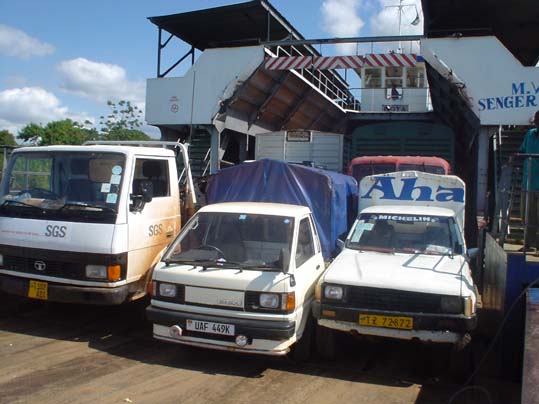
Then I ran back to the ticket
office and said: motokaa na mtu moja, surprised of my own Kiswahili. I got the
tickets and ran back to the ferry. There I pondered: six lorries, four ferry
trips a day. Lining op behind the 50 would have cost me two days or three. And
this was evaded with no bribes!
The main road to Mwanza is tarmac, I knew. Just another 20 km, almost one hour
to reach it. But whistling I bumped over the road, realizing what had just been
evaded.
The grass of the shore side of Mwanza Yacht Club, Saturday, April 30, 17:00 hrs.
No drip of water lost from my radiator since Geita. Not even a higher than
normal temperature, at least if I had learned correctly to read my involuntarily
recalibrated meter.
Mwanza Monday, May 2, 2005
Finally on the grass of the Yacht club shore with clean skin and clothes, I made coffee:
Saturday. Water
Boiling Method WBM 0.1. ("Rawhide")
Result: no coffee.
Sunday was supposed to be my day
off. But my controller Jeremia stood before my car at nine, even before I had opened my eyes. We had a morning conversation and in the afternoon, we
inspected the shipyard and talked with the boss, Daniel. This led to so many
confusing and conflicting information that only now, in the Monday morning
drizzle, after fundi (experts) took out my radiator and started to look
for replacement in town, I have the courage to think how to report on it. To
boost my morale, I light one of the Cuban cigars sent by my mother from Holland,
"Smoking is Dangerous to your Health",
with a fat line black cadre, the distant drums of western
"civilization".
Yesterday morning, after cordial greetings, Jeremia and I agreed that I should have a cold shower
to kick start my brain and he would
go with my thermos for hot coffee water.
From my side the first aim of this morning conversation was to find out who had received
money of mine and how much, who bought what and for what price, what was still
to be bought and at what price.
That seems simple but straight questions like this tend to be replied by
philosophical treatises about the details of the art of finding the wood,
discrete transport (mninga is, though commonly traded, officially protected) en
shipbuilding. After one hour I got out that 12 of 37 frames where ready, the
wood in stock would make another 6, so we would need wood for another 18 frames.
On inspection in the afternoon, the situation turned out to be like this:
I counted 10 bottom segments of frames on
double distance. That should become 12 (double distance). Then between each of the frames
another one should be fitted. Finally, a frame has not only a bottom part, but
two more parts up to 2.40 meters. The bottom part is only 30% of the frame.
Wood available for frames, according to Jeremia in the morning conversation: 16%
of all frame work. On inspection in the afternoon, Jeremia, with a big smile, led me to this heap
of wood:
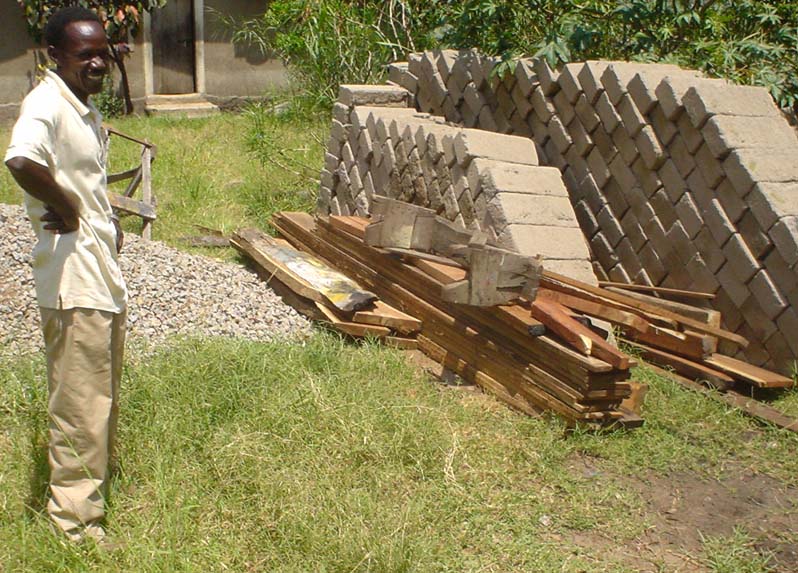
That is, 14 planks of
mninga between 11 and 7 feet, no logs suitable for frames. There was more wood
in a store, I was assured by the shipyard boss Daniel. But the guy with the key
was not around. No, indeed (on my question), bosses of shipyards do not
habitually carry the keys of their own mninga stores.
Summary on frames:
| Frames | Jeremia morning conversation | Afternoon inspection |
| Fitted | 30% | 8% |
| Wood available | 15% | 0% |
| Wood not available | 55% | 92% |
Similar sizes of logs should be bought to support the deck, counting these in this survey would result in wood for frames not available: 98%.
Frames are covered by planks of 9
by 1 inch, 10 to 11 feet long, as the long ones on the picture above, roughly )
to make hull and deck.
In the morning conversation I succeeded after trying half an hour with different
means and different types of questions from different angles to lure Jeremia out of his philosophical digressions to come up with the following statements:
A wood trader bought 60
logs for the yard to build my dhow, but they are still in the forest.
They will arrive not tomorrow, but may be Tuesday. This amounts, Jeremia says, to roughly 1500
cubic feet. The value of mninga is roughly 15 000 Tanzania Shillings.
But Jeremia! 1500 cubic feet yields 1600 m2 of hull surface and we need only
200! This wood amounts to TSh 22.5 million, or US$ 216 000. Daniel signed to finish
the whole dhow for US$ 13 000!
He will, he will.
Jeremia makes my calculation in another way to arrive at roughly the same
price and quantity. Yes, that is the price for which he buys the
mninga in town.
But Jeremia, Kees (my fellow-Dutch representative and Mwanza
business man)
paid only TSh 3 million for the wood. That amounts to
TSh 2000 per cubic foot!
That is 13% of the town price!
Yes, Jeremia says.
And we will get it for that?, that is the price in the forest?
At 13%? Tell me why?!
That question, of course, was a bad waste of time. Because I was stupid enough
to ask it myself, I had to abide the full answer. Difficulties of transport, the
road was unsafe (police), by rail difficulties of getting hold of a good wagon,
but the relations with the authorities was warmer there, nevertheless heavy
bribes, since mninga is protected etc. etc.
OK, OK.
Of course I did not repeat my error and ask why my yard was exempted from the
670% forest-to-town margin. Nor how we could cover the full hull and deck of a 20
meter, 2.4 meter high, 3 meter wide dhow with all side total surface of nearly
200 m2
with 60 planks of just over 40 m2 in total. To avoid my small headache growing, I proposed
to part and collect Jeremia from his workshop in the afternoon for inspection of
the yard.
With a sigh of relief I started to rinse my washed clothes in the Mwanza bay
and boiled some water for coffee:
Sunday. Water
Boiling Method WBM 0.2.
Upgrades: a NIDO powder milk tin can is used, with holes
drilled in the lower part and bottom. It is lighted with wood curls from
Jeremia's workshop, then dead wood found around should take over.
Result: lukewarm coffee.
At our arrival at the yard in the afternoon, boss
Daniel was
"unexpectedly" around.
I express my surprise not to see my dhow ready because our Christmas agreement
mentioned three months.
Now, Jeremia and Daniel hold firmly: six months has always been the agreement.
Daniel answers on my questions that wood trader Ahmed, who
was formerly said to be one of the yard employees, is actually called Hamadi
and not an employee but an independent wood trader. Daniel got
TSh 3 Million
(23% of the total sum contracted for the entire dhow) from Kees, he paid
TSh 2.5
Million (19%) to Hamadi, and used TSh 0.5 Million (3%) for what I was seeing
here on the yard.
From my emails with Kees I conclude that Hamadi must have received his money in
the second half of February, that is over 2 months ago. Daniel claims that Hamadi bought 70
logs, and not
planks in the forest. A
log is a beam that can be cut into 9 or 10
planks. That, I calculate in silence,
would amount to 700 planks or almost 500 m2 or enough for 2.5 dhows like mine. A
log costs TSh 133 333, thus this wood would come for
TSh 9.3 Million. In the morning conversation, Jeremia mentioned a town price of
TSh 15000 per cubic
foot and a forest price (which mysteriously would be the yards cost price) of
TSh 2000. According to Daniels figures, Hamadi delivers 2.5 times
the wood needed at the yard in town for TSh 19200 per cubic foot, that is 28% above the town price. Hamadi's wood, however, will not come Tuesday, as Jeremia
told me in the morning, but in the middle of next week.
May 10. Sure? I ask.
Jeremia translates into Kiswahili.
Jeremia and Daniel nod firmly.
What is surely in Kiswahili? I ask Jeremia.
Kwa hakika.
Kwa hakika? I ask Daniel
Kwa hakika, Daniel says.
With a smile we shake hands.
I dont believe a word of it.
On the way home Jeremia proposes to buy part of the wood not through Hamadi and at another place, Sengerema. It will be delivered dry, so we save 6 weeks for soaking and drying, and after all, who knows whether or not Hamadi's wood will turn up in ten days....
| Jeremia morning |
Daniel on inspection |
Jeremia after inspection |
|
| Delivery | In 2 days | In 10 days, kwa hakika | May be later |
| Mninga Price and Quantity bought and ready for transport in Tabora forest |
60 "planks" = 1500
CuFt
@ Forest price = Yard cost price = TSh 1950/CuFt (N.B. Town price = TSh 15 000/CuFt) |
70 "logs" = 540
CuFt for TSh 9,333,333 hence Yard cost price = TSh 17 500/CuFt |
Jeremia's morning estimate of the wood
quantity purchased is 8 times what we need, Daniels estimate on inspection is
2.5 time what we need. Daniel seems to pay 16% more than town price. Outside
Africa this would not be my business: Daniel has signed to finish my dhow for
TSh 13 Million. But since by far the largest part of these US$ 13 000 go into
wood purchase and the figures are wavering like drunkards, this clearly is not
my time just to hand out a lot of money.
Back at the Yacht Club I hear over a beer that business people
usually travel with armed guards in the region of Biharamulo
and its Game Park that I passed
through Friday, because gangs of Burundi raiders are regularly trying their luck
there.
On Monday morning, pouring rain, even before
I had opened my eyes, a brother of Kees'
wife
stood before my car with two fundis
(experts), to detach my radiator and buy a replacement. The type was not
available in Mwanza, but another one, second hand which only needed rewelding of
the bolts was for sale at US$90. After a few hours the trio returned. The bolts
were welded at the wrong place. My separate battery for light and electrical
equipment could not be charged so I went to the Yacht Clubs restaurant for a
chicken garlic with a 230 V socket to work on my laptop. Finally at the end of
the afternoon, still in the pouring rain, the replacement was done. On the
veranda, in wind, rain and 19o Celsius we heard on TV that Berlin had 28.
No way to light a fire for coffee, I had my thermos filled by means of the
restaurant's electrical cooker.
Tuesday, May 3. Ugandan Shillings are of no value in
Mwanza. Banks, hotels, nobody wants them. VISA cards yield cash, but I have a
MASTER which does not. My money will reach for three more days, then I have to
take up some of my Euro 10 000 dhow deposit with
Kees.
With the money left I buy coffee and charcoal
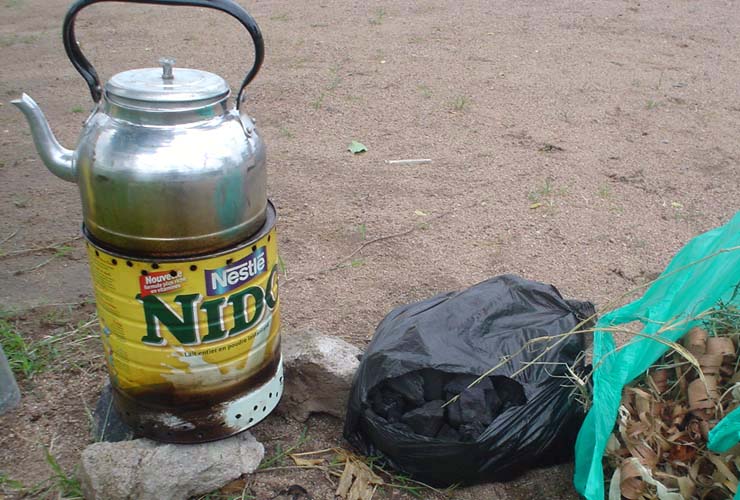
Tuesday. Water
boiling method WBM 1.0.
Upgrades: 1. more holes down. 2. now also holes
top. 3. charcoal (this bag 20 Eurocent, boils 60 big cups of coffee) instead of
dead wood.
Result: hot coffee in thirty minutes. (but see, much later,
WBM
2.0)
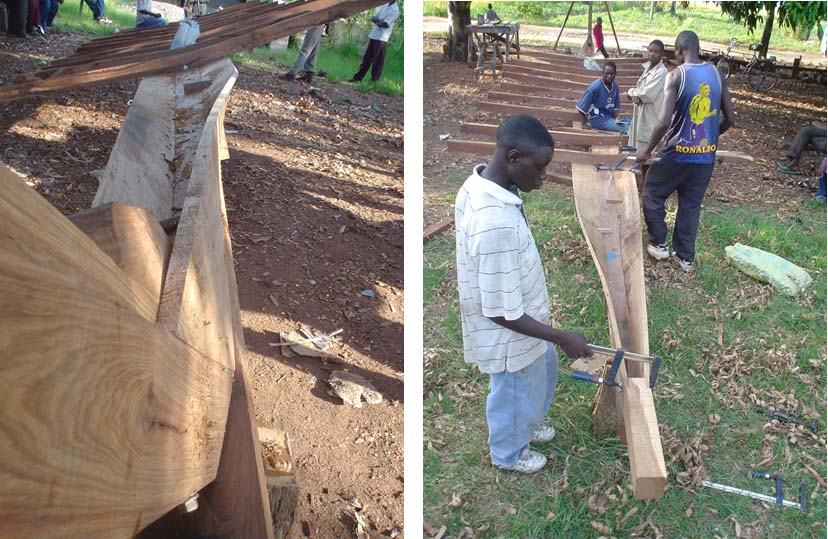
Daniel was in town and had
talked to
mninga traders. I went there with Jeremia. Daniel had found 70
planks,
almost 10% of our needs, for sale in town at
TSh 16000 per
CuFt. That makes Tsh 1 Million. Four asking
eyes in my direction.
We can buy that from our money that is now in Hamadi's pocket, I said. He has
used it for two months, buying and selling wood with it, so we should ask him
also our rightful share of the profits he thus made.
Disappointment. This could not be done. In the end Hamadi would come with that
wood.
Then if we buy now in town, in the end we shall have too much. Hamadi should
know we now need wood, from him or someone else. On next week Wednesday May 10
kwa hakika
he should bring good quality mninga to a value of at least our advance of TSh
2 5 Million or
bring that money. Then we are free again to buy when and where we want..
It took Jeremia some time to explain this to Daniel. Eyes flared up.
What's the news from Hamadi? I asked.
He has a small wagon.
That was good news because mninga comes by train from 400 km South: the forests
(or what is left of them) of Tabora..
OK, I said, then we wait buying wood till May 10
kwa hakika
and then see from there.
But screws, Daniel said. We need 50 boxes of 100 copper screws @ TSh
15 000.
That is a lot, a say, that is US$ 750.
Is it a fair price? I ask Jeremia.
Jeremia nods.
Why do we need all of them right now?
This is a special offer, and the screws are a special size that is not always
available. We don't want to have the wood and then sit again waiting for screws.
Sounds convincing. It is a lot of money, but I think we could do that. I will
talk about it with Mr. Kees.
OK.
Suddenly all three hundred guests of the big tent-cafe stand up jubilating in a
deafening noise. A man called Salim Hamed Salim had just been announced to be
elected president or something else very important of Tanzania.
After we can hear each other again Jeremia says: Daniel asks what about the
wood.
I explain that I like the idea of supplying the yard to get work done, but I do
not like to postpone the Hamadi issue because it keeps my advance above the
acceptable level. I will think about it. I will tell you tomorrow.
At home I decide that for the wood, May 10 kwa hakika, 6 days from now, is a delay of 9% more, which I should wait for. If no wood, then follows the stand off with Hamadi, if necessary, and we start buying with the money he returned. As for the screws, I decide to take one from the yard and inquire about its price and the regularity of its supply in town.
| Greetings Home |
| Previous Greeting |
| Next Greeting |
| Previous Dhow Logbook |
| Next Dhow Logbook |